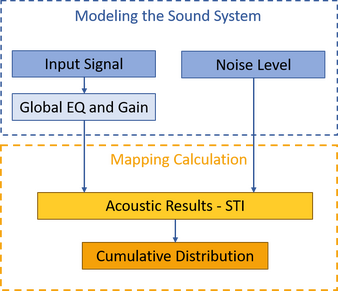EASE 5 First Edition facilitates state-of-the-art assessment of speech intelligibility

"As a certified engineering office for planning VA systems we’re aware of being in charge of safety-relevant aspects of the project. We’re happy to rely on EASE 5-FE as efficient tool for standard-conform STI and RT calculations and based on acoustic parameters of the room. This is how we support the technical planners and architects in an efficient and cost-saving way."
Benedikt Kühle, Ingenieurbüro Ostendorf & Partner GmbH & Co. KG
Evaluating and optimizing the speech transmission index (STI) is an important component for the successful realization of many sound system designs and room acoustic projects. The index is an established and reliable indicator for speech intelligibility in buildings ranging from lecture halls to airports, and plays, in addition, an important role for planning voice alarm systems. There are national and international standards specifying recommended or required STI values, typically referring to IEC 60268-16 as the basis for determining the STI. Version 5.50 of EASE 5-FE now offers a complete toolset for standard-compliant STI calculations for the first time.
In order to assess the STI values in EASE 5-FE, the input signal fed to the sound system can be selected, global EQ and gain can be adjusted, and the background noise level can be defined by the user. The actual calculation of the STI values according to IEC standard 60268-16 can be performed in EASE 5-FE, both statistically based on Eyring’s approximation, as well as using the AURA raytracing module, allowing full-length impulse response analysis. Calculated STI values are presented in mappings, tables, and distribution statistics.

- To ensure compliance with the standard, the speech input signal according to IEC 60268-16 can be selected in the acoustic parameters window of EASE 5-FE. This program signal represents the average frequency spectrum of male speakers and has an emphasis on the low frequency bands.
- For the ambient noise, values measured on site or standard curves can be used in 1/3rd or 1/1 octave resolution. An assumed broadband level can be entered, as well.
- Optimizing the speech intelligibility in a room is often an iterative process that involves balancing the effect of signal masking at high signal levels with the influence of a low signal-to-noise ratio at low signal levels. For this purpose, EQ adjustments and high-pass filters may be applied, as well as the gain may be set globally, by group, or individually per loudspeaker.
- Computation results for the STI can be displayed and analyzed in 3D mapping plots, at individual receiver points, as well as statistically. In particular, the cumulative distribution graph allows making statements about the frequency and the minimum values of the STI across the considered audience area. In this manner, requirements such as the guaranteed STI for 90% of the listening area can be evaluated and compliance with standards like NFPA 72 or ISO 7240-19 and its national implementations like German VDE 0833-4 can be verified.
If you want to map the complete chain from input signal to evaluation in conformity with current standards, EASE 5-FE is the right tool for you!
Feel free to contact us for further discussion of technical aspects or register directly for a free trial for EASE 5-FE.
We look forward to your feedback and comments, you are welcome to share them with other users in our AFMG Network Forum.

Important Note
EASE 4 users upgrading to EASE 5 will retain their existing EASE 4 license. In this manner, the transition to the new platform can happen smoothly and will take into account already running projects.